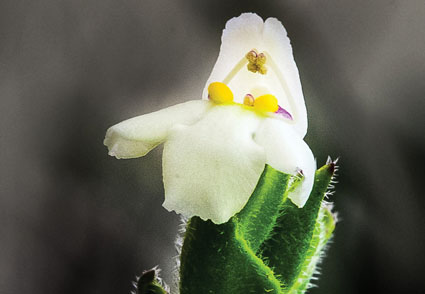Abstract
There are currently only two species of Craterostigma recognised for South Africa, C. plantagineum and C. wilmsii. The present paper deals with the Craterostigma plants from the Pondoland Centre of Floristic Endemism along the eastern coast of South Africa. It is presently a synonym of C. plantagineum, an inland species of high elevations. However there are differences between C. plantagineum and the Pondoland plants, and a case is made for the re-instatement of C. nanum for the latter. An expanded description is provided, along with a proposed conservation assessment, and key to the species in South Africa.
References
<p align="justify"><span style="color: #000000;"><span style="font-family: Times New Roman, serif;"><span style="font-size: small;">Diels, L. (1898) Beiträge zur Kenntnis der Scrophulariaceen Afrikas II. In: A. Engler, Beiträge zur Flora von Afrika XVI. Botanische Jahrbücher fur Systematik, Pflanzengeschite und Pflanzengeographie 26 (2): 120–123. [https://www.biodiversitylibrary.org/page/165110#page/131/mode/1up]</span></span></span>
<p align="justify"><span style="color: #000000;"><span style="font-family: Times New Roman, serif;"><span style="font-size: small;">Drège, J.F. (1843) Zwei Pflanzengeographische Documente von J.F.Drège. In: Meyer, E. (Ed.) Besondere Beigabe zur Flora 1843, II. Regensburg, Leipzig, 230 pp. https://doi.org/10.5962/bhl.title.87612</span></span></span>
<p align="justify"><span style="color: #000000;"><span style="font-family: Times New Roman, serif;"><span style="font-size: small;">Engler, A. (1895) Die Pflanzenwelt Ost-Afrikas und der Nachbargebiete. Deutch Öst-Africa 5 (C). Dietrich Reimer, Berlin, pp. 357. https://doi.org/10.5962/bhl.title.587</span></span></span>
<p align="justify"><span style="color: #000000;"><span style="font-family: Times New Roman, serif;"><span style="font-size: small;">Fischer, E. (1986) Systematisch-morphologische Untersuchungen zur Gliederung und Abgrenzung der Gattung Craterostigma Hochstetter 1841 s.l. unter Berücksichtigung von Chamaegigas Dinter.Diploma thesis, University of Mainz, Mainz.</span></span></span>
<p align="justify"><span style="color: #000000;"><span style="font-family: Times New Roman, serif;"><span style="font-size: small;">Fischer, E. (1992) Systematik der afrikanischen Lindernieae (Scrophulariaceae). Tropische und Subtropische Planzenwelt 81. Franz Steiner Verlag, Stuttgard, 365 pp.</span></span></span>
<p align="justify"><span style="color: #000000;"><span style="font-family: Times New Roman, serif;"><span style="font-size: small;">Fischer, E., Schäferhoff, B. & Müller, K. (2013) The phylogeny of Linderniaceae – The new genus Linderniella, and new combinations within Bonnaya, Craterostigma, Lindernia, Micranthemum, Torenia and Vandellia. Willdenowia 43: 209–238. https://doi.org/10.3372/wi.43.43201</span></span></span>
<p align="justify"><span style="color: #000000;"><span style="font-family: Times New Roman, serif;"><span style="font-size: small;">Hemsley, W.B. & Skan, S.A. (1906) Scrophulariaceae. In: Thiselton-Dyer, W.T. (ed.) Flora of Tropical Africa 4 (2). Lovell Reeve & Co., London, pp. 261–462. [https://www.biodiversitylibrary.org/item/127#page/272/mode/1up]</span></span></span>
<p align="justify"><span style="color: #000000;"><span style="font-family: Times New Roman, serif;"><span style="font-size: small;">Hiern, W.P. (1904) Scrophulariaceae. In: Thiselton-Dyer, W.T. (ed.) Flora capensis 4 (2). Lovell Reeve & Co., London, pp. 121–420. [https://www.biodiversitylibrary.org/item/15241#page/129/mode/1up]</span></span></span>
<p align="justify"><span style="color: #000000;"><span style="font-family: Times New Roman, serif;"><span style="font-size: small;">Hochstetter, C.F.F. (1841) Nova genera plantarum Africae tum australis tum tropicae borealis proponit et describit.. Flora 24 (2): 657–672. [https://www.biodiversitylibrary.org/item/937#page/275/mode/1up]</span></span></span>
<p align="justify"><span style="color: #000000;"><span style="font-family: Times New Roman, serif;"><span style="font-size: small;">IPNI (2021+) The International Plant Names Index. Available from http://www.ipni.org (continuously updated; accessed April 2020).</span></span></span>
<p align="justify"><span style="color: #000000;"><span style="font-family: Times New Roman, serif;"><span style="font-size: small;">IUCN (2001) IUCN Red List Categories and Criteria: version 3.1. IUCN Species Survival Commission. IUCN, Gland, Switzerland, 30 pp.</span></span></span>
<p align="justify"><span style="color: #000000;"><span style="font-family: Times New Roman, serif;"><span style="font-size: small;">JSTOR (2021+) Global Plants. Available from: http://plants.jstor.org/search?asf (Accessed July 2021).</span></span></span>
<p align="justify"><span style="color: #000000;"><span style="font-family: Times New Roman, serif;"><span style="font-size: small;">Leistner, O.A. & Morris, J.W. (1976) Southern African place names. Annals of the Cape Provincial Museum 12: 1–565. [https://www.biodiversitylibrary.org/item/211761#page/9/mode/1up]</span></span></span>
<p align="justify"><span style="color: #000000;"><span style="font-family: Times New Roman, serif;"><span style="font-size: small;">Linnaeus, C. (1753) Species Plantarum 2. Laurentius Salvius, Stockholm, 639 pp. https://doi.org/10.5962/bhl.title.37656</span></span></span>
<p align="justify"><span style="color: #000000;"><span style="font-family: Times New Roman, serif;"><span style="font-size: small;">Mucina, L., Rutherford, M.C. & Powrie, L.W. (2006) Vegetation Atlas of South Africa, Lesotho and Swaziland. In: Mucina, L.M. & Rutherford, M.C. (eds.) The vegetation of South Africa, Lesotho and Swaziland. Strelitzia 19. South African National Biodiversity Institute, Pretoria, pp.749–790. https://hdl.handle.net/20.500.12143/328</span></span></span>
<p align="justify"><span style="color: #000000;"><span style="font-family: Times New Roman, serif;"><span style="font-size: small;">Oliver, D. (1885) Craterostigma nanum var. elatior. In: Hooker, J.D. (ed.) Hooker’s Icones Plantarum: Figures with descriptive characters and remarks, of new and rare plants 15: 63, t. 1479. [https://www.biodiversitylibrary.org/item/54716#page/64/mode/1up]</span></span></span>
<p align="justify"><span style="color: #000000;"><span style="font-family: Times New Roman, serif;"><span style="font-size: small;">South African National Biodiversity Institute. (2021) Botanical Database of Southern Africa (BODATSA). Available at (Accessed July 2021).</span></span></span>
<p align="justify"><span style="color: #000000;"><span style="font-family: Times New Roman, serif;"><span style="font-size: small;">Thiers, B. (2021+) Index Herbariorum: A global directory of public herbaria and associated staff. New York Botanical Garden’s Virtual Herbarium. Available at http://sweetgum.nybg.org/ih/ (continuously updated; accessed 7 July 2021).</span></span></span>
<p align="justify"><span style="color: #000000;"><span style="font-family: Times New Roman, serif;"><span style="font-size: small;">Van Wyk, A.E. & Smith, G.F. (2001) Regions of floristic endemism in Southern Africa: A review with emphasis on succulents. Umdaus Press, Pretoria, 199 pp.</span></span></span>
<p align="justify"><span style="color: #000000;"><span style="font-family: Times New Roman, serif;"><span style="font-size: small;">Wettstein, R. von (1891) Scrophulariaceae. In: Engler, A. & Prantl, K. (eds.) Die Natürlichen Pflanzenfamilien 4 (3b). W Engelmann, Leipzig, pp. 39–107. [https://www.biodiversitylibrary.org/item/100228#page/47/mode/1up]</span></span></span>


